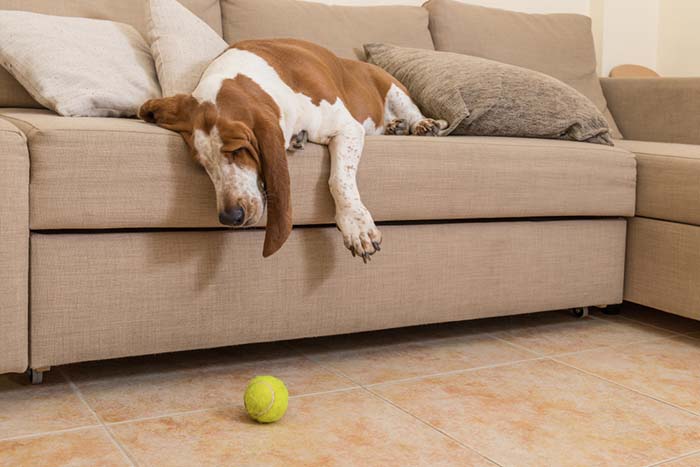Many owners come across a specific problem – their dogs won’t play with them. If you find yourself in that situation, there are many reasons why a dog may not play with you or his toys. So let's take a look at the most common causes of this passive behavior and what you can do if your dog won't play with you.
Old Age
As dogs age, they have less energy and they become affected by numerous health conditions. This is not unusual, especially for breeds that are not very active by nature, like English Mastiffs or Bulldogs.
What to Do:
If you have a senior or aging dog, do not be too concerned over the lack of interest in play – it's natural. If there are some other symptoms that follow the lack of playfulness, then it could be a health issue and you should take your dog to the vet.
However, it's recommended to encourage play in senior dogs to prevent early cognitive dysfunctions. There are a few things you can do to stimulate your aging dog to play. Take him swimming, which is a great activity for older dogs. Take regular mentally stimulating walks (i.e. going to new places, seeing new things) and reward your dog with treats.
Play games like Food Hunt or Hide and Seek with treats. Use toys appropriate for older dogs, especially softer toys. If your dog is very old and not in good physical shape, choose games that require less movement and activity, like Three Cup Monte, with a treat in one of the cups.
Health Problems
Any changes in your dog’s usual behavior, including a lack of playfulness, can often be a sign that something is wrong with his health. Dental health issues, for example, are often a reason for decreased desire to play and commonly ignored by pet owners.
Other health issues, like being overweight, arthritis, respiratory problems or mental health issues can also make your dog lethargic. Depression, although still not a proven condition in dogs, can be the culprit as well, at least according to John Ciribassi, DVM, past president of the American Veterinary Society of Animal Behavior.
What to Do:
Take your dog to the vet and listen to his advice if you get a diagnosis that proves your dog has a health issue. There's a number of health problems a senior dog may need to deal with, and each one will have to be addressed differently. Often, proper mental stimulation may be the answer to get your pooch out of apathetic behavior and get him be more social and active again.
Why Your Dog Won’t Play from the Start
It's normal for senior dogs to lose interest in play, but this behavior is far less common in puppies or adult dogs. So if you have recently adopted a dog, whether he is a puppy or an adult, and he's not playful, or your pup suddenly started showing lack of playfulness – this can be due to multiple reasons.
Fear
Fear can be the most important factor that causes your dog to avoid playing with you. This is especially true if you have adopted a rescue dog. It is quite possible that he is not used to play and lived through some traumatic experiences with the previous owner.
What to Do:
You must be patient – rescue dogs need time to adjust. Be calm and let your dog accept you at his own pace. He must be able to trust you before he can start playing with you. If you have other dogs, let the dog observe how you play with them. Don’t try to rush him and force him to play.
Watch your body language. Most of us throw our hands in the air when we want to play with our dogs. However, a dog that hasn’t yet developed trust and has bad experiences with previous owners can easily take that as a threat. Keep your arms by your side and don’t make a lot of motion with them. Your entire body language should be as non-threatening as possible.
Inexperience
If you have a puppy or you adopted a rescue dog, you might have to teach them how to play. Once again, past experience teach dogs different things so they need to readjust. Puppies learn from their mother but after that they can only learn from you.
What to Do:
Work with your dog when he is young and socialize him. Provide ample playing time and opportunities for play. Some dogs are playful by nature and don’t need a lot of work, but others have to be taught how to play. If you create a stimulating environment, you will have an active adult dog.
Keep a positive playing attitude. Be enthusiastic about playing with your dog, but don’t sound overexcited. Provide your dog with many different toys and rotate them. Show interest in his toys when you want to play with him to encourage him to show interest as well. Also, teasing your dog a bit is good, but don’t overdo it or you will frustrate him.
 Remember that you control the game. Stop playing with your dog if he gets too excited and aggressive. Also, stop the game before your dog stops on his own. He will stop playing when he becomes tired or bored and if you end the game before that, he will be interested and excited to play again later.
Remember that you control the game. Stop playing with your dog if he gets too excited and aggressive. Also, stop the game before your dog stops on his own. He will stop playing when he becomes tired or bored and if you end the game before that, he will be interested and excited to play again later.
Your approach can also be wrong. Dogs don’t react the same way to different “play signals”. For example, patting the floor is not as effective as some people think, according to a study that Scientific American wrote about. However, chasing your dog or running from him had much more success, stimulating dogs to play 100% of the time.
READ NEXT: Dog Isn’t Playful Anymore – What Could Be the Problem?














